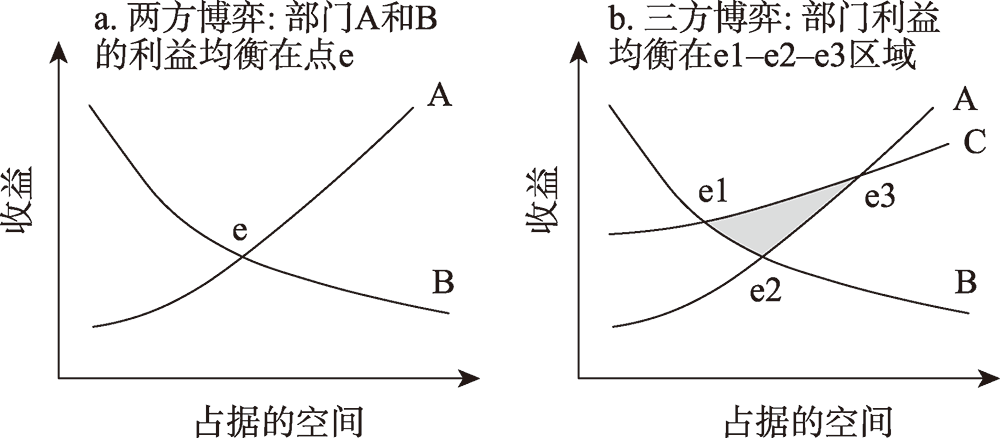

JOURNAL OF NATURAL RESOURCES >
A conflict coordination approach for territory spatial planning based on security pattern theory
Received date: 2021-10-11
Revised date: 2022-05-23
Online published: 2023-01-28
Facing the territorial symptom such as urban sprawl, rural decline, and environmental degradation, territory spatial planning needs to integrate multiple plans that reflect the maximum interests of various stakeholders and usual conflict between them to achieve "Multi-Plan Integration". This paper proposes an approach to coordinate the conflicts between different plans based on security pattern theory. This approach mainly includes: (1) On the epistemology level, territory spatial planning is considered as a rational planning process, in which the generated plans are defensible by adopting the minimax-constraint approach, and the outcomes are acceptable by all stakeholders through the spatial game to coordinate their competitions for limited land. (2) On the methodology level, the first stage is to identify security patterns functioning as the basis for safeguarding the goals of all stakeholders and the coordination etween them, and the second stage is to negotiate on the use of competitive land using these security patterns. In practice, it is essential to establish an institutional mechanism to coordinate planning conflicts. Moreover, for the disadvantageous position of natural and ecological capitals in multi-party games, it is necessary to construct an ecological security pattern and ecological infrastructure to provide comprehensive ecosystem services, which would help to reinvent the good earth.

PENG Xiao . A conflict coordination approach for territory spatial planning based on security pattern theory[J]. JOURNAL OF NATURAL RESOURCES, 2022 , 37(11) : 2856 -2866 . DOI: 10.31497/zrzyxb.20221107
表1 最大—最优化与最小—最大约束途径的比较Table 1 The comparisons between Maximization-optimization approach and Minimax-constraint approach |
| 项目 | 最大—最优化途径 | 最小—最大约束途径 |
|---|---|---|
| 经济指标 | 追求经济效益,试图最大化社会总效益与社会总成本的差值,采用各类经济学优化方法 | 追求避免很高的社会成本,采用预警原则(Precautionary Principals)、最低安全指标(Safe Minimum Standards)、可持续限制(Sustainable Constraints)、发展阈限(Development Thresholds)等方法 |
| 生态指标 | 追求生态适宜性和最佳关系,采用生态适宜性分析等方法 | 追求避免生态的不可逆恶化,采用承载力(Carrying Capacity)、顶级环境阈限(Ultimate Environmental Thresholds)等方法 |
注:引自参考文献 [28]。 |
表2 常见的空间过程及模型Table 2 Essential spatial processes and models |
| 以内容而言 的过程 | 以空间方向而言的过程 | |
|---|---|---|
| 水平过程 | 垂直过程 | |
| 非生物过程 | 风、水、土壤、营养物质等在景观中的流动;景观层面的能量交换;在景观上传播的扰动,如火等 | 和气象、地质条件有关的土壤发育;在地表不同要素层之间的能量和物质交换;在特定地方发源并局限在该地的自然事件,如湿地的季节性淹没和地质结构相关的滑坡(也是水平过程) |
| 生物过程 | 生物体的移动和迁徙;被隔离生境间的种群动态;生境的重新占据;基因流;害虫传播等 | 对一个场地的适应过程;群落演替;地方种群动态;物种与特定生境的交互等 |
| 人文过程 | 旅游游憩过程;土地扩张和城市开发;人口迁移和扩散等 | 基于特定资源条件的生产过程;在一个特定社区中的人口结构动态;和一个地方的资源、文化和历史过程相关的视觉感知过程等 |
| 过程模型 | 如重力模型、潜力模型、扩散模型、网络模型、流体动力学模型、集合种群动态模型、可视性模型、成本—距离等阻力模型 | 如土壤发育模型、种群增长模型、生态系统模型、演替模型、生态顶级模型、生物与文化适应模型等 |
:感谢北京大学俞孔坚教授在论文写作过程中的倾力指导。
| [1] |
中华人民共和国水利部. 水利部关于加强城市水利工作的若干意见, http://www.mwr.gov.cn/zw/tzgg/tzgs/201702/t20170213_854695.html, 2006-11-23.
[Ministry of Water Resources of the People's Republic of China. Opinions of the Ministry of Water Resources on strengthening urban water conservancy work, http://www.mwr.gov.cn/zw/tzgg/tzgs/201702/t20170213_854695.html, 2006-11-23.]
|
| [2] |
王会肖, 王红瑞. 中国水生态水环境的若干问题及其对策. 科学对社会的影响, 2006, (1): 21-26.
[
|
| [3] |
俞孔坚, 李迪华, 李海龙, 等. 国土生态安全格局:再造秀美山川的空间战略. 北京: 中国建筑工业出版社, 2012.
[
|
| [4] |
中华人民共和国水利部. 2014中国水资源公报,http://szy.mwr.gov.cn/dflygz/201509/t20150906_719810.html, 2015-09-06.
[Ministry of Water Resources of the People's Republic of China. 2014 China Water Resources Bulletin, http://szy.mwr.gov.cn/dflygz/201509/t20150906_719810.html, 2015-09-06.]
|
| [5] |
中华人民共和国环境保护部, 国土资源部. 2014全国土壤污染状况调查公报, http://www.gov.cn/govweb/foot/site1/20140417/782bcb88840814ba158d01.pdf, 2014-04-17.
[Ministry of Environmental Protection of the People's Republic of China, Ministry of Land and Resources of the People's Republic of China. 2014 Report on the national general survey of soil contamination, http://www.gov.cn/govweb/foot/site1/20140417/782bcb88840814ba158d01.pdf, 2014-04-17.]
|
| [6] |
中国人民共和国国家林业和草原局. 第二次全国湿地资源调查主要结果(2009—2013年), http://www.forestry.gov.cn/main/65/content-758154.html, 2014-01-28.
[The State Forestry Administration of the People's Republic of China. Main results of the second national wetland resources survey (2009-2013), http://www.forestry.gov.cn/main/65/content-758154.html, 2014-01-28.]
|
| [7] |
|
| [8] |
|
| [9] |
|
| [10] |
李琳, 韩贵锋, 赵一凡, 等. 国土空间规划体系下的“多规合一”探讨与展望. 西部人居环境学刊, 2020, 35(1): 43-49.
[
|
| [11] |
林坚, 陈霄, 魏筱. 我国空间规划协调问题探讨: 空间规划的国际经验借鉴与启示. 现代城市研究, 2011, 26(12): 15-21.
[
|
| [12] |
刘彦随, 王介勇. 转型发展期“多规合一”理论认知与技术方法. 地理科学进展, 2016, 35(5): 529-536.
[
|
| [13] |
谢英挺, 王伟. 从“多规合一”到空间规划体系重构. 城市规划学刊, 2015, (3): 15-21.
[
|
| [14] |
中共中央国务院关于建立国土空间规划体系并监督实施的若干意见,http://www.gov.cn/zhengce/2019-05/23/content_5394187.htm, 2019-05-23.
[Several opinions of the Central Committee of the Communist Party of China and the State Council on establishing the land spatial planning system and supervising the implementation, http://www.gov.cn/zhengce/2019-05/23/content_5394187.htm, 2019-05-23.]
|
| [15] |
党安荣, 田颖, 甄茂成, 等. 中国国土空间规划的理论框架与技术体系. 科技导报, 2020, 38(13): 47-56.
[
|
| [16] |
邓凌云, 曾山山, 张楠. 基于政府事权视角的空间规划体系创新研究. 城市发展研究, 2016, 23(5): 24-30, 36.
[
|
| [17] |
林坚, 陈诗弘, 许超诣, 等. 空间规划的博弈分析. 城市规划学刊, 2015, (1): 10-14.
[
|
| [18] |
林坚, 乔治洋. 博弈论视角下市县级“多规合一”研究. 中国土地科学, 2017, 31(5): 12-19.
[
|
| [19] |
李迪华. 国土空间规划体系中景观设计学科与行业的困惑及机遇. 景观设计学, 2020, 8(1): 84-91.
[
|
| [20] |
林坚. 国土空间规划理论与实践. 西部人居环境学刊, 2020, 35(1): 4.
[
|
| [21] |
|
| [22] |
|
| [23] |
俞孔坚. 生物保护的景观生态安全格局. 生态学报, 1999, 19(1): 10-17.
[
|
| [24] |
俞孔坚, 李迪华, 刘海龙, 等. 基于生态基础设施的城市空间发展格局: “反规划”之台州案例. 城市规划, 2005, (9): 76- 80, 97-98.
[
|
| [25] |
俞孔坚, 王思思, 李迪华, 等. 北京市生态安全格局及城市增长预景. 生态学报, 2009, 29(3): 1189-1204.
[
|
| [26] |
俞孔坚, 李海龙, 李迪华, 等. 国土尺度生态安全格局. 生态学报, 2009, 29(10): 5163-5175.
[
|
| [27] |
俞孔坚, 李迪华. 论反规划与城市生态基础设施建设. 中国科协2002年学术年会, 2002: 26-37.
[
|
| [28] |
俞孔坚. 可持续环境与发展规划的途径及其有效性. 自然资源学报, 1998, 13(1): 8-15.
[
|
| [29] |
|
| [30] |
|
| [31] |
|
| [32] |
|
| [33] |
|
| [34] |
|
| [35] |
|
| [36] |
|
| [37] |
|
| [38] |
|
| [39] |
|
| [40] |
|
| [41] |
|
| [42] |
|
| [43] |
|
| [44] |
张年国, 王娜, 殷健. 国土空间规划“三条控制线”划定的沈阳实践与优化探索. 自然资源学报, 2019, 34(10): 2175-2185.
[
|
| [45] |
王检萍, 余敦, 卢一乾, 等. 基于“三生”适宜性的县域土地利用冲突识别与分析. 自然资源学报, 2021, 36(5): 1238-1251.
[
|
| [46] |
俞孔坚, 李迪华, 韩西丽. 论“反规划”. 城市规划, 2005, (9): 64-69.
[
|
/
| 〈 |
|
〉 |